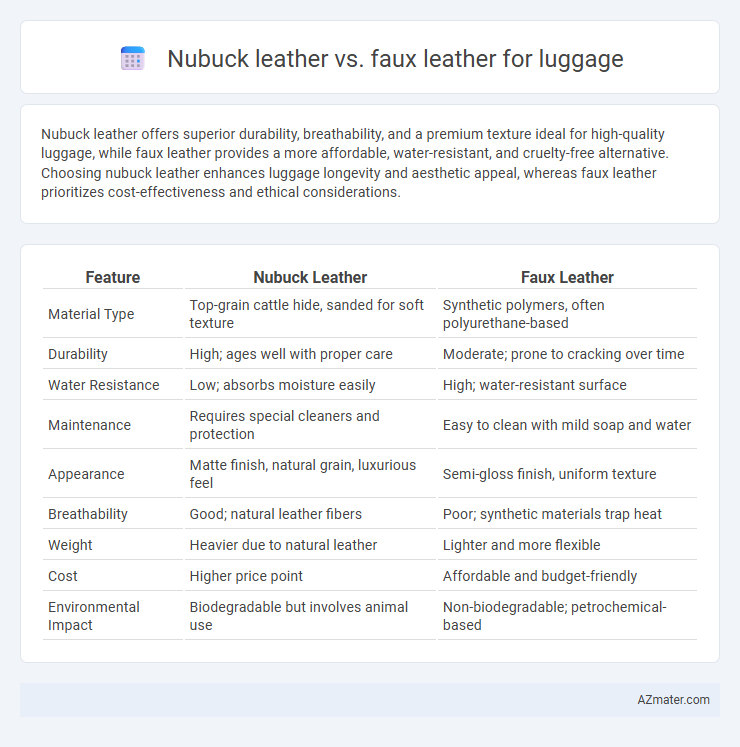Nubuck leather offers superior durability, breathability, and a premium texture ideal for high-quality luggage, while faux leather provides a more affordable, water-resistant, and cruelty-free alternative. Choosing nubuck leather enhances luggage longevity and aesthetic appeal, whereas faux leather prioritizes cost-effectiveness and ethical considerations.
Table of Comparison
| Feature | Nubuck Leather | Faux Leather |
|---|---|---|
| Material Type | Top-grain cattle hide, sanded for soft texture | Synthetic polymers, often polyurethane-based |
| Durability | High; ages well with proper care | Moderate; prone to cracking over time |
| Water Resistance | Low; absorbs moisture easily | High; water-resistant surface |
| Maintenance | Requires special cleaners and protection | Easy to clean with mild soap and water |
| Appearance | Matte finish, natural grain, luxurious feel | Semi-gloss finish, uniform texture |
| Breathability | Good; natural leather fibers | Poor; synthetic materials trap heat |
| Weight | Heavier due to natural leather | Lighter and more flexible |
| Cost | Higher price point | Affordable and budget-friendly |
| Environmental Impact | Biodegradable but involves animal use | Non-biodegradable; petrochemical-based |
Introduction to Nubuck and Faux Leather
Nubuck leather, a top-grain cowhide that is buffed to create a velvety surface, offers durability and a premium feel ideal for high-end luggage. Faux leather, crafted from synthetic materials like polyurethane, provides a cost-effective, water-resistant alternative that mimics genuine leather's appearance without animal products. Choosing between nubuck and faux leather depends on factors like budget, maintenance preferences, and desired texture for luggage applications.
Material Composition: Nubuck vs Faux Leather
Nubuck leather is crafted from top-grain cattle hide, sanded and buffed to create a soft, velvety texture, offering natural breathability and durability ideal for premium luggage. Faux leather, typically made from polyurethane (PU) or polyvinyl chloride (PVC) coatings on fabric backings, mimics real leather's appearance but lacks its natural porosity and strength. The material composition impacts luggage performance, with nubuck providing enhanced aging qualities and faux leather offering water resistance and lower maintenance.
Durability and Longevity Comparison
Nubuck leather offers superior durability and longevity for luggage due to its natural grain and ability to develop a rich patina over time, resisting wear and tear effectively. Faux leather, while more affordable and resistant to water and stains, generally lacks the long-term durability and aging characteristics of nubuck, making it more prone to cracking and peeling. For luggage intended to withstand frequent use and maintain aesthetic appeal, nubuck leather remains the preferred choice for durability and extended lifespan.
Appearance and Aesthetic Differences
Nubuck leather boasts a velvety, matte finish with a soft texture that develops a rich patina over time, enhancing its luxurious and natural appearance. Faux leather for luggage typically features a uniform, glossy or semi-glossy surface that mimics traditional leather but often lacks the depth and natural variation found in nubuck. The aesthetic difference lies in nubuck's ability to age gracefully with unique wear patterns, whereas faux leather maintains a consistent look that can appear more synthetic and less authentic.
Maintenance and Cleaning Requirements
Nubuck leather requires regular maintenance using specialized leather conditioners and gentle cleaning with a soft brush to preserve its texture and prevent stains. Faux leather offers easier cleaning and durability, typically needing only wiping with a mild soap solution and a damp cloth to maintain its appearance. Both materials benefit from prompt stain treatment, but nubuck demands more careful handling to avoid water damage and fading.
Water Resistance and Weather Performance
Nubuck leather offers moderate water resistance but requires regular treatment to maintain its durability and prevent water damage, making it less ideal for frequent exposure to harsh weather. Faux leather provides superior water resistance and resists moisture penetration better, ensuring luggage stays dry during wet conditions. Weather performance of faux leather is generally more reliable for luggage, as it withstands rain and humidity without losing structural integrity or appearance.
Eco-Friendliness and Sustainability
Nubuck leather, derived from top-grain cattlehide, offers high durability and breathability but involves significant environmental impact due to livestock farming and tanning chemicals. Faux leather, often made from polyurethane or PVC, reduces reliance on animal agriculture but raises concerns over plastic pollution and non-biodegradability. Choosing sustainable luggage hinges on factors like production methods, material lifespan, and recyclability, with emerging plant-based and recycled faux leathers presenting more eco-friendly alternatives.
Cost Analysis: Nubuck vs Faux Leather Luggage
Nubuck leather luggage typically costs significantly more than faux leather due to its high-quality, natural material sourced from top-grain cattle hides, which demands extensive processing and craftsmanship. Faux leather, made from synthetic materials like polyurethane, offers a budget-friendly alternative with lower production costs and greater mass-market availability. Buyers seeking durability and a premium aesthetic often invest in nubuck, while cost-conscious consumers prefer faux leather for affordable, stylish luggage options.
Comfort and User Experience
Nubuck leather offers superior breathability and softness, enhancing comfort during extended travel by reducing hand fatigue and improving grip on luggage handles. Faux leather, while more affordable and water-resistant, often lacks the natural texture and cushioning that contribute to a comfortable user experience. Travelers prioritizing long-term use and tactile satisfaction tend to prefer nubuck leather for its premium feel and durability despite its higher maintenance needs.
Which Luggage Material is Best for You?
Nubuck leather offers a luxurious, durable, and breathable option ideal for high-end luggage that ages beautifully with time, but it requires careful maintenance to prevent stains and water damage. Faux leather provides a budget-friendly, water-resistant, and low-maintenance alternative that is lightweight and cruelty-free, making it suitable for frequent travelers seeking practical durability. Choosing the best luggage material depends on your priorities: opt for nubuck leather for premium style and longevity, or faux leather for affordability and ease of care.

Infographic: Nubuck leather vs Faux leather for Luggage
 azmater.com
azmater.com